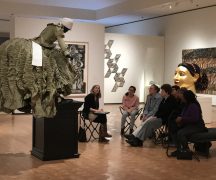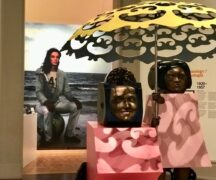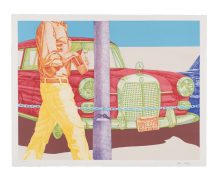From TOLEDO MUSEUM OF ART
TOLEDO – A rare opportunity to see more than 80 modern works of studio glass from private and corporate collections is being offered in a special exhibition this spring and summer at the Toledo Museum of Art Glass Pavilion.
Hot Spot: Contemporary Glass from Private Collections, which opens April 15 and continues through Sept. 18 showcases contemporary North American, European, Australian and Asian studio glass. Many of the objects are on public view for the first time.
Curated by Jutta-Annette Page, TMA’s senior curator of glass and decorative art, the exhibition celebrates the 10th anniversary of the opening of the SANAA-designed Glass Pavilion as well as shines a light on the impressive and storied glass legacy at TMA.
The works of art will be featured in seven thematic groups – the human figure, animals and plants, landscapes, vessel forms, the spirit world, abstract forms and outer space. Among the artists are Joyce Scott, Nicholas Africano, Tom Moore, Kimiake Higuchi, Preston Singletary, Debora Moore and Tobias Møhl.
“This exhibition is the perfect way to reflect on current directions in the studio glass movement in the U.S. as well as studio glass from around the world, particularly work by glass artists not currently represented in TMA’s collection,” Page said. “Toledo is the Glass City and the Toledo Museum of Art, as a major player in the history of studio glass as an art form, is committed to nurturing innovative contemporary glass artists through its collections, programs and facilities.”
The Hot Spot exhibition is made possible by 2016 Exhibition Program Sponsor ProMedica, by Museum members and by a sustainability grant from the Ohio Arts Council.
Admission to the Glass Pavilion and the exhibition is free. Parking is free for Museum members and $5 for nonmembers. For more information, visit http://www.toledomuseum.org/
TMA’s role in the American Studio Glass movement
It was in 1962 in a garage on Museum grounds where glass pioneer Harvey Littleton, then a pottery instructor, received the support of TMA Director Otto Wittmann to conduct a glass workshop to explore molten glass in a studio setting rather than a factory. An experimental furnace was built, and though initial attempts to fuse molten glass failed, with assistance from artist and master glass craftsman Dominick Labino on furnace construction, the artists were able to realize the fundamental requirements for this new studio technique.
In 1969, TMA became the first museum to build a facility and studio dedicated to and designed specifically for teaching glass technique.
The landmark Glass Pavilion was designed by Kazuyo Sejima and Ryue Nishizawa, lead architects of SANAA, the Pritzker Prize-winning architecture firm based in Tokyo, and joined the architecturally distinctive TMA 36-acre campus in 2006. The exterior and many of the interior walls of the 74,000-square-foot building are made entirely of glass. Itself a work of art, the structure serves as both a museum housing TMA’s renowned glass holdings and as a studio.
________________________________________
Toledo Museum marks 10th anniversary of opening of Glass Pavilion with “Hot Spot” exhibit





